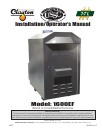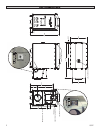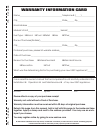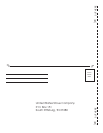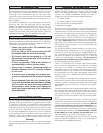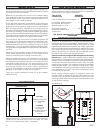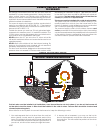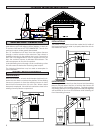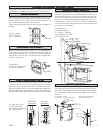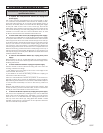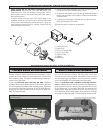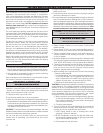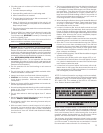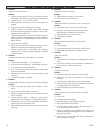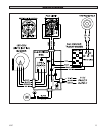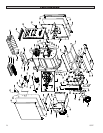
6 USSC
Clearances to combustible materials will vary with the type
of ue connection used. Be sure to maintain the specied
clearances for your type of installation.
TYPE OF FLUE REQUIRED
CONNECTION CLEARANCE
Class A 103HT All-Fuel or Equivalent .....2”
Double Wall, Stainless Steel or ...............6”
Double Wall, Black Pipe w/
Stainless Steel Inner wall
24 Gauge or Heavier .............................20”
Single Wall Stainless Steel
or Black Pipe
22”
12”
20”
15”
COMBUSTIBLE WALL
COMBUSTIBLE WALL
FLUE
(TOP VIEW)
MINIMUM CLEARANCES
TO A COMBUSTIBLE
WALL
CAUTION:
DO NOT store
combustible or
flammable materials or
liquids near the
furnace.
Sides of furnace, 12”; Rear of furnace, 15” (allow approxi-
mately 20” for the return box); Front of furnace, 36”; Heat
Duct, 2” for the rst 9 feet then 1” thereafter.
A Class “A” HT 2100 All Fuel 6” Chimney Pipe and Base Plate
should be used for the installation. See Illustration. Place
the Base Plate over the ue outlet of the furnace and drill
eight(8) pilot holes into the Cabinet Top. Apply a generous
amount of high temperature sealant to the bottom of the
base plate, and around the ue outlet. Position the base
plate over the ue and secure with the eight(8) screws
provided. Then attach the ue pipe sections.
A minimum chimney height of 6 feet is required not including
the rain cap. In order to determine proper chimney height
above the roof, measure from the side of the chimney hori-
zontally. As you move up the chimney, the length increases.
Once this measurement reaches 10 feet, this is the base
height of the chimney. The chimney must be 2 feet taller
than the base height. If the chimney is closer than 10 feet
from the peak of the roof, the chimney must be 2 feet taller
than the peak of the roof. The 2 feet measurement does
not include the rain cap.
Once correct chimney height is achieved, check the
chimney draft. It should not exceed 0.06 inches of water
column. Then secure with three screws at each joint and
attach guy wires down to the rings located around the top
of the furnace cabinet.
See illustration.
The above clearances to combustibles must be
maintained.
Some important rules for preparing good rewood are: Cut,
split and stack the wood in the early spring and let it stand
in the sun and wind all summer.
Whether you purchase your wood or cut it yourself, spring
is the best time to buy or cut your wood to insure it is good
and dry come winter. If you live in a damper climate, it will
take longer for the wood to season.
By far the most important characteristic of any rewood
is its moisture content. Firewood with a moisture content
higher than twenty percent will burn, but it will be hard to
light and keep burning, will make a lot of smoke and will
produce less efcient res with lower sustained BTU output.
Plus much of its energy content will be wasted right up the
chimney. Firewood should be between 15 and 25 percent
moisture to burn properly and to get that dry it must be split
and stacked in the open for at least a full summer.
All wood burns, but wood that’s cut green (between 50
and more than 100 percent moisture content) burns with
more difculty, because the water in the wood must be
boiled off before the actual wood ber can burn. Air-dried
(“seasoned”) wood is generally between 20-30 percent.
Kiln-dried rewood generally contains less than 20 percent
moisture.
Green wood can produce more creosote--a black sooty
liquid which deposits and hardens on the inside of your
chimney and can ignite, causing a chimney re.
When you stack your wood, you should stack it in an open
location where the summer sun can warm it and breezes
can help remove moisture. Be sure to cover the top of the
wood pile to keep the rain out. It is important that you do
not stack unseasoned wood in an unventilated area for
it will not dry properly. You shouldn’t allow your rewood
to lay on the ground for more than a couple days before
stacking , or it will start to mold and rot quickly.
Once your wood is seasoned, store it in a dry location
before burning.
CLEARANCES
WOOD SUPPLY FLUE PIPE INSTALLATION
CHIMNEY REQUIREMENTS



